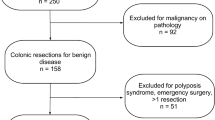Abstract
Background: Little recent data exist relative to the efficacy or postprocedural complications of surgeons performing diagnostic or therapeutic colonoscopy. Therefore, the aim of this study was to retrospectively assess the outcome of colonoscopy performed by surgeons.
Methods: The charts of 2,069 patients who underwent colonoscopy between January 1992 and April 1995 by one of four surgeons at one of two centers were reviewed. Parameters included demographics, indications, procedures and findings, pathology, major complications, length of procedures and dosage of medication.
Results: 2,069 colonoscopies were performed for the following indications: 877 polyp surveillance, 509 cancer surveillance, 287 rectal bleeding, 282 family history of colon cancer, 127 change in bowel habits, 112 polyps found by flexible sigmoidoscope or barium enema, 92 inflammatory bowel disease, 48 preoperation, and 58 other indications. Some patients had more than one indication. The cecum could not be intubated in 73 cases (3.5%) due to narrowing and stricture [33] redundancy [18], poor preparation [14], and other miscellaneous conditions [8]. The average procedure time in the 1,023 cases in which it was measured was 34.7 min. Average sedation doses were 2.1 mg of midazolam and 75.2 mg of meperedine in these same cases.
The 2,069 colonoscopies included 1,878 biopsies, 353 polypectomies, and 139 other procedures. Some patients had multiple therapeutic interventions. Findings included 2,107 polyps, the pathology of which included 907 tubular; 62 tubulovillous and 41 villous adenomas, 325 hyperplastic polyps, and 68 carcinomas. There were five major complications after polypectomies (0.2%) including two cases of bleeding and three perforations. The two patients with bleeding were admitted to hospital, one for observation for 2 days and the other for colonoscopy, coagulation, and transfusion of 3 units of blood. Of the three patients with perforation, one underwent hospitalization for intravenous antibiotics and the other two for surgery (0.01%). Surgery included one resection with primary closure of the sigmoid perforation and one colostomy.
Conclusions: This study confirms the observation that colonoscopy performed by surgeons is safe and rapid whether performed as a therapeutic or as a diagnostic procedure.
Similar content being viewed by others
Author information
Authors and Affiliations
Additional information
Received: 15 December 1997/Accepted: 11 March 1998
Rights and permissions
About this article
Cite this article
Wexner, S., Forde, K., Sellers, G. et al. How well can surgeons perform colonoscopy?. Surg Endosc 12, 1410–1414 (1998). https://doi.org/10.1007/s004649900870
Published:
Issue Date:
DOI: https://doi.org/10.1007/s004649900870




